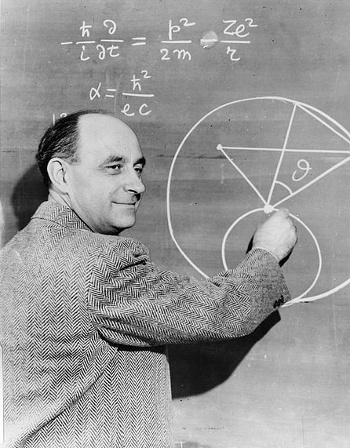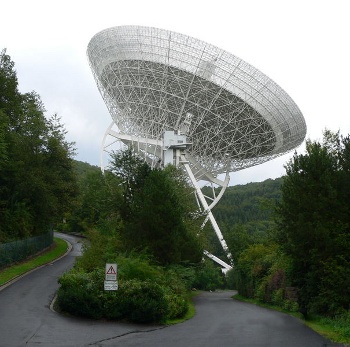Proton to Electron Mass Ratio
January 11, 2013
Over the years, there have been quite a few
astronomical observations that have sought to determine something of very fundamental importance; namely, are the
physical constants actually constant, or do they have values that change with
time as our
universe expands.
Dirac, himself,
published a paper on this idea in 1938, stating that
"...there is no definite reason why the constants of atomic theory should not appear in cosmology - in fact, one would expect them to, since one would expect a closer connexion between the atom and the cosmos to show itself with a deeper understanding of Nature."[1]
Something that sounds so
cosmological as variable physical constants can actually be checked very close to the
Earth.
Thomas Van Flandern, who was an
astronomer with the
United States Naval Observatory, thought that a temporal change in the
gravitational constant could be seen in the
orbit of the Moon.[2]
Unfortunately, Van Flandern is better known for his wild speculations on various topics, as
his Wikipedia entry will show. That notwithstanding, he was still a foremost authority on the orbit of the Moon, and he coauthored a
widely used algorithm for calculating the
Julian date from the
Gregorian date.[3]
Every
physicist's favorite
dimensionless constant is the
fine-structure constant, commonly symbolized as
α. The fine structure constant is related to some rather fundamental things; namely, the
elementary charge e,
Planck's constant h, the
speed of light c and the mathematical constant
π,
α = (2 π e2)/(h c)
Since the fine structure constant agrees with
quantum electrodynamics to eleven
decimal places, any suggestion that it's variable requires
considerable evidence. You must also ask yourself, has it changed because
e,
h or
c has changed?
In a
previous article (Alpha Anisotropy, November 30, 2011), I reviewed evidence that
α might not be that constant on a cosmological scale. A team of
radio astronomers from
Australia and the
UK determined that
α is either higher or lower than the terrestrial value, depending on the measurement direction.[4-5]

One example of the fine-structure constant changing with time.
In this photograph, Enrico Fermi has written the wrong equation for α. The symbol h-bar is known as the reduced Plank Constant. It's h divided by 2π
Fermi's sly smile might indicate that he did this on purpose; or, this is an early example of a photobomb.
(Smithsonian Institution photograph, via Wikimedia Commons.)
The research team measured the
absorption spectrum of the
intergalactic medium between Earth and
quasars visible in the
northern and
southern hemispheres. Their data showed a dipole at the
4.2-sigma level. The putative dipole direction is 17.5 ± 0.9 h
right ascension, -58 ± 9 deg
declination.[4-5]
Another interesting dimensionless number is
μ, the
proton-to-electron mass ratio, which is
presently known to be 1836.15267245. In 1951, when this constant was measured to be 1836.12, Friedrich Lenz of
Düsseldorf, Germany, published a one-sentence paper in the
Physical Review stating that this number was very nearly
6π5 (1836.11810845).[6] Nowadays, it's possible to find many such relationships using
computers, none of which are worthwhile without a backing
theory.
Scientists at the
Vrije Universiteit (Amsterdam, The Netherlands) and the
Max Planck Institute for Radio Astronomy (Bonn, Germany) decided to check whether
μ has changed with time. To accomplish this, they used the
100-meter radio telescope at Effelsberg, Germany, operated by the Max Planck Institute for Radio Astronomy, to examine the
absorption spectrum of
methanol.[7-8]
They observed absorption lines for methanol in the spectrum of PKS1830-211, a
lensed quasar with a lensing
galaxy at a
redshift of about 0.89.[9] This redshift places the lensing galaxy at a time seven billion years in the past. Four spectral lines were observed around 25
GHz for methanol, two of which would be especially sensitive to
μ.[7] They found that at that redshift,
Δμ/μ = (0.0 ± 1.0) x 10−7, which is essentially a
null result.[8]
Said
Karl Menten, Director at the Max Planck Institute for Radio Astronomy,
"If we were really to find deviations in this fundamental constant, we would have a problem with our understanding of the foundations of physics... Most importantly, this would violate Einstein's equivalence principle, the cornerstone of the general theory of relativity."[7]

The 100 meter radio telescope at Effelsberg, Germany.
(Photograph by Hans-Peter Scholz Ulenspiegel, artistically modified, via Wikimedia Commons)
![]()
References:
- P.A.M. Dirac, "A New Basis for Cosmology, Proc. Roy. Soc. London, vol. A165 (1938), pp. 199-208.
- T. C. Van Flandern, “Is the gravitational constant changing?”. Astrophysical Journal, vol. 248 (1981), pp. 813-816.
- Henry F. Fliegel and Thomas C. van Flandern, "Letters to the editor: a machine algorithm for processing calendar dates,"Communications of the ACM, vol. 11, no. 10 (October, 1968), p. 657.
- J. K. Webb, J. A. King, M. T. Murphy, V. V. Flambaum, R. F. Carswell and M. B. Bainbridge, "Indications of a Spatial Variation of the Fine Structure Constant," Physical Review Letters, vol. 107, no. 19 (November 4, 2011), Document No. 191101.
- J. K. Webb, J. A. King, M. T. Murphy, V. V. Flambaum, R. F. Carswell and M. B. Bainbridge, "Indications of a spatial variation of the fine structure constant," arXiv Preprint Server, November 1, 2011.
- Friedrich Lenz, "The Ratio of Proton and Electron Masses," Phys. Rev., vol. 82, no. 4 (May, 1951), pp. 554–554
- Physical constant passes the alcohol test - Fundamental properties of molecules have not changed during the past seven billion years, Max-Planck-Gesellschaft, München, Press Release, December 13, 2012.
- Julija Bagdonaite, Paul Jansen, Christian Henkel, Hendrick L. Bethlem, Karl M. Menten and Wim Ubachs, "A Stringent Limit on a Drifting Proton-to-electron Mass Ratio from Alcohol in the Early Universe," Science Express, December 13, 2012, DOI: 10.1126/science.1224898.
- T. Wiklind and F. Combes, "The redshift of the gravitational lens of PKS1830–211 determined from molecular absorption lines," Nature, vol. 379, no. 6561 (January 11, 1996), pp. 139-141.
- E. J. Salumbides, M. L. Niu, J. Bagdonaite, N. de Oliveira, D. Joyeux, L. Nahon and W. Ubachs, "The CO A-X System for Constraining Cosmological Drift of the Proton-Electron Mass Ratio," arXiv Preprint Server, August 23, 2012
Permanent Link to this article
Linked Keywords: Astronomy; astronomical; physical constant; time; metric expansion of space; universal expansion; Paul Dirac; scientific literature; cosmology; cosmological; Earth; Thomas Van Flandern; astronomer; United States Naval Observatory; gravitational constant; orbit of the Moon; Wikipedia; algorithm; Julian date; Gregorian date; physicist; dimensionless quantity; dimensionless constant; fine-structure constant; elementary charge; Planck constant; Planck's constant; speed of light; quantum electrodynamics; decimal place; Marcello Truzzi; radio astronomer; Australia; United Kingdom; Enrico Fermi; photobomb; Wikimedia Commons; absorption spectroscopy; absorption spectrum; intergalactic dust; quasar; northern hemisphere; southern hemisphere; normal distribution; 4.2-sigma; right ascension; declination; proton-to-electron mass ratio; Düsseldorf, Germany; Physical Review; computer; theory; scientist; Vrije Universiteit (Amsterdam, The Netherlands); Max Planck Institute for Radio Astronomy (Bonn, Germany); 100-meter radio telescope at Effelsberg, Germany; absorption spectrum; methanol; gravitational lens; quasar; galaxy; redshift; GHz; null result; Karl Menten; Einstein; equivalence principle; general theory of relativity.